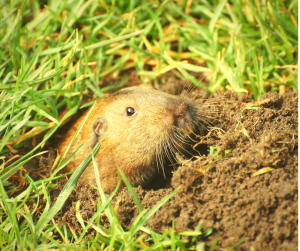Garden Clean Up and Gophers
With warmer and milder days the home gardener can water and clean up the garden. Watering thoroughly every ten days or two weeks is preferable to a light watering more often. This deep watering will bring trees, shrubs and perennials into healthy growth. True, the cold of winter may have damaged some plants irreparably. If that has happened there is only one action open. The rosarians have a saying which fits. “Prune with a shovel.” Yes, only one avenue is open to the serious gardener. Dig up the dead or dying plant and throw it away. Make room for new strong replacements.
 The great temptation is to wait and see what thrives after the cold, cold weather. With rose bushes, shrubs, fruit trees do give those which appear likely good plants a chance. Sometimes very cold weather forces the severe pruning which gardeners should do occasionally. You can wait until late May or early June to determine whether these actually are dead, dying, or just dormant. Remember the plants which usually come out late. They may be even later leafing out this year. Allow them time enough before digging up so that if in a state of true dormancy the plants can overcome that.
The great temptation is to wait and see what thrives after the cold, cold weather. With rose bushes, shrubs, fruit trees do give those which appear likely good plants a chance. Sometimes very cold weather forces the severe pruning which gardeners should do occasionally. You can wait until late May or early June to determine whether these actually are dead, dying, or just dormant. Remember the plants which usually come out late. They may be even later leafing out this year. Allow them time enough before digging up so that if in a state of true dormancy the plants can overcome that.
Do not feed plants too soon. This will help avoid too early greening or tender new growth before weather is warm enough to support it. As you clean in the garden, watch for signs of gophers. Before plants and lawns help to hide the work of these rodent pests search out their mounds and tunnels. Freshly mounded loose dirt often tells the story of these four-footed diggers. They use their front feet and two vicious long front teeth to dig. Sometimes after watering a step on the softened ground will cave in a gopher’s tunnel. These small members of the rodent family are usually six to ten inches long.
Gopher tunnels can wreck a lawn, a flower garden or a planting of young trees. Tunnels are usually a few inches below surface but may be as much as two feet deep. Even the hard clay soils, the caliche and hard pan soils, seem not to deter these hard working rodents. Besides their propensities for undermining gardens and lawns these small pests eat almost any sort of plant. Bulbs, tubers, vegetables, weeds, annuals, perennials, shrubs, tree roots, grasses, all are on the gopher list of preferred foods. These annuals can ruin alfalfa fields, young orchards, or implanted prairie lands, as well as tasty home garden plantings.
 There are a number of control methods for gophers. Especially needed are controls for these deadly enemies of the gardener because a single female gopher has from one to five litters of five to eight young per year. This population explosion in the garden can be held down by having cats and dogs in the yard. The gardener who has a rat or gopher hunting pet is fortunate. However, cats and dogs can not always get into the runs to catch the culprits. Dachshunds are especially fine rodent hunters as they are by nature adept at this type hunting.
There are a number of control methods for gophers. Especially needed are controls for these deadly enemies of the gardener because a single female gopher has from one to five litters of five to eight young per year. This population explosion in the garden can be held down by having cats and dogs in the yard. The gardener who has a rat or gopher hunting pet is fortunate. However, cats and dogs can not always get into the runs to catch the culprits. Dachshunds are especially fine rodent hunters as they are by nature adept at this type hunting.
King or gopher snakes, skunks and barn owls are the best other natural enemies of gophers. Few town residents are blessed with these predators. Placing a hose down a hole which shows fresh evidences of digging and flooding out gophers can do the eradication job. But sometimes these tunnel experts close off tunnels or even plug the mound holes and go merrily on their chewing way. In that case trap the rodents. Gopher traps can be purchased from feed and seed men or sellers of nursery supplies. The trap must be placed at the burrow entrance after setting its trap device. Stake the trap down securely. Cover It with grass or weeds.
A home-made wooden trap can serve the purpose, also. Some local gardeners trap gophers and then drive miles out in the country to release them. This is just removing the immediate cause and does not cut down on the total number of rodents. There are gas bombs which can be purchased to use against gophers. Be very careful in using these so that children playing, or pets will not suffer from the effects of undispersed gas.
Often these are temporary measures of control. The pesky diggers may just move to another area to carry on their mining operations. But they are less likely to stay around where there are cats and dogs in the area. So give the pest ample time to chase after the rodent population of your garden. Good hunting.



Comments are closed, but trackbacks and pingbacks are open.